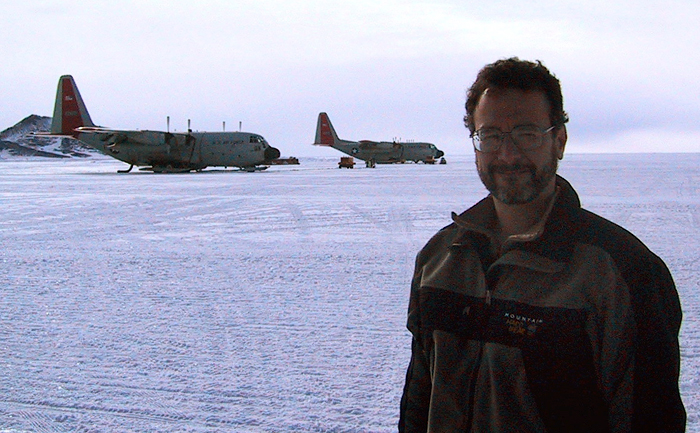Scambos: Larsen C realistic model for studying AntarcticaSea ice acts as this great buffer. … When you get into the sea ice [on an icebreaker] within five, 10 kilometers, suddenly it’s like you’re in a building. Everybody comes out of their room. They’re not sick anymore. People you haven’t seen in a week are suddenly in the galley. That’s because the sea ice has dampened down the wave action considerably.” Glaciologist Doug MacAyeal, of the University of Chicago
“That launched the whole idea that we needed to take a closer look,” Scambos said. “We thought about it and suspected before, but that really showed us there is some major connectivity to wave trains and large bergs that we had not completely explored.”
Related Story
But the cause and effect relationship isn’t that simple. Seismic waves from the Indian Ocean tsunami in 2004 hit stable ice shelves along the coast of East Antarctica head on. None of the ice shelves responded to the blow.
“It has to be a combination of events,” Scambos said. “You have to have an ice shelf teetering on the brink, and then this rumpling at the edges sends it over in this runaway decay process.
“These things are responding slowly, but they get to the point where they suddenly break apart.”
Q: Will you ever be able to collect enough data to model and predict ice shelf collapse?
After a long pause: “Yes. It would be a really hazy, risky model.” Such a model, Scambos explained, would require a number of thresholds be met, such as temperature and sea ice extent, before one could predict a collapse. Even then, the best estimate would be a plus or minus of a decade.
“The ability to predict is based on a steady extrapolation of a really noisy year to year signal in terms of weather.”
Q: To continue on the theme of ice shelves, you have a pretty big IPY project coming up during the 2009-10 field season called LARISSA [for LARsen Ice Shelf System Antarctica]
“The overarching goal is to examine every aspect of an ecosystem and glacial system evolving under a very rapidly warming climate as an analog, in this case, for the rest of Antarctica.
“The Antarctic system, in general, is snowfall high up on the plateau, great big glaciers that flow out, and usually there’s a huge ice shelf in the Antarctic system fronting these ice shelves.
“As you go through warming, that ice shelf can suddenly disappear, [causing] big changes to the ecosystem — benthic and surface — and big changes to the glaciers because you’ve lost the back stress that the ice shelf provides on this glacial outflow.
“The Larsen is a big enough system that it’s a realistic model of what’s going to happen to the Antarctic, but yet small enough so that the [RVIB Nathaniel B.] Palmer
Q: Few argue that the planet is undergoing a change in its climate. Global temperatures are rising, entire ecosystems are shifting such as in the Antarctic Peninsula, and the oceans are acidifying, threatening marine life on a broad scale. Yet there’s still the debate about whether these events are largely natural variability or the result of anthropogenic input. What convinced you that human activities are driving climate change?
“I think I was still on that fence — more in that sense of natural variability or is it really climate change — in the late 90s. By the time the Larsen B [ice shelf] came around [in 2002] that wasn’t quite the epiphany moment. It had already happened, but the Larsen B was pretty emphatic evidence that we were going to see severe changes and that things were happening now that had not occurred in the previous minor warmings on the Earth before.
“This time it’s different. An ice plate [Larsen B] that had been there for 10,000 years was disintegrating tells us that this is not like the Medieval Warm Period, not like the Climate Optimum …”
Scambos said data from ice cores drilled in Greenland and Antarctica first convinced him that humans were largely responsible for global climate change. He is particularly interested in seeing the results from the West Antarctic Ice Sheet drilling project
“I’m hoping WAIS core gives us some details,” he said. Ice cores contain a wealth of information about past climate, a study called paleoclimatology. For instance, bubbles of gas trapped in the ice from hundreds of thousands of years ago can tell scientists about the past climate, which they can then extrapolate into the future.
“In other words, [we] use the big changes that have happened in the past to tell us the net result of what this [human] experiment will be for climate change. Models are really having trouble dealing with the complexity of the system. We’ve seen it in how fast the Arctic sea ice is disappearing.
The North Pole, he added, could be ice-free in five or 10 years. “Any day now,” he quipped. “We’re in the range where a hot summer could melt all of it away.”
NSF-funded research in this story: Ted Scambos, National Snow and Ice Data Center, Award No. 0732921 and Award No. 0538103
|



For USAP Participants |
For The Public |
For Researchers and EducatorsContact UsU.S. National Science FoundationOffice of Polar Programs Geosciences Directorate 2415 Eisenhower Avenue, Suite W7100 Alexandria, VA 22314 Sign up for the NSF Office of Polar Programs newsletter and events. Feedback Form |


